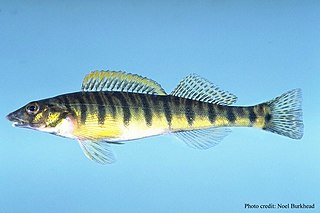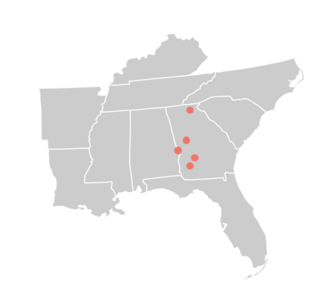
Percina is a genus of small freshwater ray-finned fish, classified within the subfamily Etheostomatinae, part of the family Percidae, which also contains the perches, ruffes and pikeperches from North America. Like the similar fishes in the genus Etheostoma, they are some species called "darters". More specifically, the genus as a whole is known as roughbelly darters, while certain species of Percina with a pattern of vertical bars on the flanks are called logperches.

The leopard darter is a species of freshwater ray-finned fish, a darter from the subfamily Etheostomatinae, part of the family Percidae, which also contains the perches, ruffes and pikeperches. It is native to the United States, where it can be found only in the Little River drainage in Oklahoma and Arkansas. Its typical habitat is medium to large streams with rubble and boulder substrate. It feeds on small invertebrates on the riverbed and spawns mainly in March and April. It is threatened by impoundment, habitat loss and runoff from agricultural activities. It has never been a common species and has been listed as a threatened species in the United States since 1978, and the International Union for Conservation of Nature lists it as a "vulnerable species".
Percina austroperca, the southern logperch, is a small species of freshwater ray-finned fish, a darter from the subfamily Etheostomatinae, part of the family Percidae, which also contains the perches, ruffes and pikeperches. They are highly resilient with a minimum population doubling time of less than 15 months. It is found in the Escambia and Choctawhatchee river systems in western Florida and southern Alabama.

Percina burtoni, the blotchside logperch or blotchside darter, is a small, endangered species of freshwater ray-finned fish, a darter from the subfamily Etheostomatinae, part of the family Percidae, which also contains the perches, ruffes and pikeperches. It is endemic to the United States and classified as vulnerable on the IUCN Red List.

The bluestripe darter is a species of freshwater ray-finned fish, a darter from the subfamily Etheostomatinae, part of the family Percidae, which also contains the perches, ruffes and pikeperches.
The longnose darter is a species of freshwater ray-finned fish, a darter from the subfamily Etheostomatinae, part of the family Percidae, which also contains the perches, ruffes and pikeperches. It is endemic to the United States.
The stargazing darter is a species of freshwater ray-finned fish, a darter from the subfamily Etheostomatinae, part of the family Percidae, which also contains the perches, ruffes and pikeperches. It is endemic to the United States.

Medionidus penicillatus, the gulf moccasinshell, is a rare species of freshwater mussel in the family Unionidae, the river mussels. This aquatic bivalve mollusk is native to Alabama, Florida, and Georgia in the United States, where it is in decline and has been extirpated from most of the rivers it once inhabited. It is a federally listed endangered species of the United States.
Percina kusha, the bridled darter, is a species of freshwater ray-finned fish, a darter from the subfamily Etheostomatinae, part of the family Percidae, which also contains the perches, ruffes and pikeperches. It is one of the 324 fish species found in Tennessee.

Percina maculata, the blackside darter, is a species of freshwater ray-finned fish, a darter from the subfamily Etheostomatinae, part of the family Percidae, which also contains the perches, ruffes and pikeperches. It is a widespread inhabitant of streams and rivers in the Mississippi River watershed. Like other darters it prefers rocky riffles and sandy runs, but is tolerant of pools and still water as well. It is one of the 324 fish species found in Tennessee.

The blackbanded darter is a species of freshwater ray-finned fish, a darter from the subfamily Etheostomatinae, part of the family Percidae, which also contains the perches, ruffes and pikeperches. It is native to the river systems of the southeastern United States where it is found in the states of South Carolina, Tennessee, Georgia, Florida, Mississippi, Alabama, and Louisiana. It lives over sandy or gravelly bottoms in smaller rivers and streams and its color varies depending on the different habitats in which it lives. It feeds on small insect larvae and is itself preyed on by larger fish. It spawns between February and June depending on locality. It is a common fish throughout most of its range but is rare in the Altamaha River in Georgia.
Percina peltata, the shield darter, is a species of freshwater ray-finned fish, a darter from the subfamily Etheostomatinae, part of the family Percidae, which also contains the perches, ruffes and pikeperches. It is endemic to the eastern United States.

Percina roanoka, the Roanoke darter, is a species of freshwater ray-finned fish, a darter from the subfamily Etheostomatinae, part of the family Percidae, which also contains the perches, ruffes and pikeperches. It isnative to Virginia, West Virginia and North Carolina in the United States. It is found in the Roanoke, Tar, and Neuse river systems, typically in small to medium size rivers. It is a colorful species with an average length of 4.3 centimeters (1.7 in). It feeds on insect larvae and other small invertebrates, and spawns in late May and June. It is a common fish with a very wide range and the International Union for Conservation of Nature has classified its conservation status as being of "least concern".

The Guadalupe darter is a small species of freshwater ray-finned fish, a darter from the subfamily Etheostomatinae, part of the family Percidae, which also contains the perches, ruffes and pikeperches. It is found in the Guadalupe River system in Texas. It prefers fast rocky runs of small to medium-sized rivers. The darter is typically 11.0 cm (4.3 in) in length.

The Halloween darter is a small freshwater fish native to North America. It is found in Georgia and Alabama in the drainage basin of the Apalachicola River, specifically in the Flint River system and the Chattahoochee River system. It prefers shallow, fast-flowing areas with gravel bottoms in small and medium-sized rivers. It was first described in 2008, having not previously been distinguished from the blackbanded darter (P. nigrofasciata), which occurs in the same watershed. The color is somewhat variable, being generally blackish dorsally, with some individuals having indistinct saddle-like barring. Males have orange and dark lateral striping while females have dark stripes and a yellowish-green belly. At a maximum standard length of 101 mm (4 in), males are slightly larger than females, and both sexes develop distinctive orange barring on the edge of the first dorsal fin during the breeding season.
The chainback darter is a species of freshwater ray-finned fish, a darter from the subfamily Etheostomatinae, part of the family Percidae, which also contains the perches, ruffes and pikeperches. It is found in North America where it occurs in the Roanoke-Chowan river drainage in Virginia south to the Neuse River drainage in North Carolina. It prefers gravel runs and riffles of small to medium-sized rivers.
The stripeback darter is a species of freshwater ray-finned fish, a darter from the subfamily Etheostomatinae, part of the family Percidae, which also contains the perches, ruffes and pikeperches. It is found in Chesapeake Bay tributaries in Maryland, Virginia, and West Virginia. It prefers gravel runs and riffles of small to medium-sized rivers.
The sharpnose darter is a species of freshwater ray-finned fish, a darter from the subfamily Etheostomatinae, part of the family Percidae, which also contains the perches, ruffes and pikeperches. It is found in North America where it occurs in the southern tributaries of upper Ohio River, to the Kentucky River in Kentucky, south in the New River drainage to North Carolina. It prefers gravel runs and riffles of small to medium-sized rivers.
The muscadine darter is a small freshwater species of freshwater ray-finned fish, a darter from the subfamily Etheostomatinae, part of the family Percidae, which also contains the perches, ruffes and pikeperches. It is found in streams above the Fall Line in the Tallapoosa River system in eastern Alabama and western Georgia. It prefers gravel runs and riffles of small to medium-sized rivers. The specific name honors the American ichthyologist William F. Smith-Vaniz for his contributions to ichthyology and for the writing the first book on the Freshwater Fishes of Alabama.










